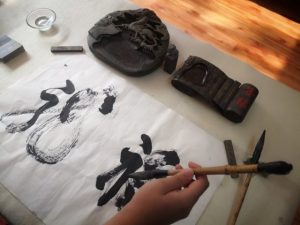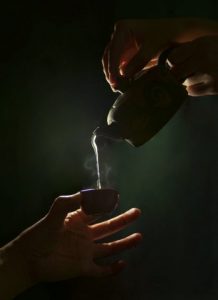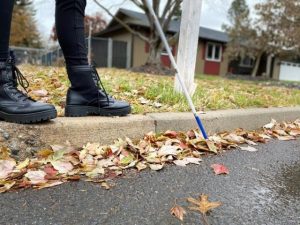
Xiaolong Zhao (19) – Baotou, Inner Mongolia, China
The objects in the picture are called the Four Treasures of the Study. They are brushes, inkstones, paperweights, and Xuan paper. On the right of the photograph, one brush is made of wolf hair and the other is made of wool. They have different nib hardnesses because they have different functions. On the top of the picture is the inkstone decorated by a carved dragon and a Chinese scroll, which symbolizes majesty. The inkstone is a special stone, and its function is to hold the ink stick that will be ground and mixed with water to make liquid ink, which will be transferred to the right container. On the left of the picture are two paperweights, and the pattern on them is bamboo from the Three Friends of Winter. These two heavier stones are responsible for keeping the paper flat. In the middle is Xuan paper, a specially crafted calligraphy paper. The word written on the paper is 福(blessing)—this Chinese character symbolizes peace and happiness. My mother and I like to use these tools to practice calligraphy. In the picture, I am writing calligraphy. My mother taught me calligraphy when I was very young. For my family, calligraphy not only represents a skill; it also cultivates one’s mind and temperament. Because of my studies, I do not have time to study calligraphy systematically. Whenever I have free time, I always like to open the window and let the sunshine and breeze sprinkle onto the desk in the warm afternoon air. I like to feel the roughness of the ink particles and the smoothness of the Xuan paper, and forget all the worries in life to make my artwork.
I have always been curious about the evolution of other scripts, such as the ancient Greek alphabet, Egyptian hieroglyphs, cuneiform, and Indus Scripts. Unfortunately, these scripts and their cultures have all fallen into the long river of history. These characters are like mysterious codes waiting for humans to crack. There is only a little connection between them and the modern scripts, and their vitality is like a flame from a burned out candle. At this time, I feel the greatness of Chinese characters more and more. This is the only living ancient writing system with its own unique writing methods and instruments. I feel very fortunate that my culture is not locked away in a museum. It is in the homes of ordinary Chinese people who love and are still writing calligraphy, a part of the Chinese culture. Whenever I hold a brush, I feel I am connected to history. Whether it is ancient poetry or novels, ancient military orders or edicts, they were all written with the tools in my hand and the characters I use. How romantic is this! It’s like passing the Olympic flame. Every Chinese dynasty, every Chinese emperor, and every ordinary person will pass the Chinese culture from generation to generation. The fire of the times burns traces of the old dynasty, but they cannot burn away all the traces of culture. This is not only a miracle for the Chinese people but also a miracle for humanity. Today, Chinese traditional culture has met with modern development. Calligraphy has a new life, and people don’t need to commemorate it because it still exists.

Marlene Auer (16) – Weimar, Germany
Navigating Progress
We live in a constantly moving and developing world. We have rapidly progressed from gravel to asphalt roads and from maps to complex technological navigation systems. We use the nighttime to work and travel just as commonly as daytime, which is what my photograph reflects. I used a low ISO value, a focal ratio of 6, and a shutter speed of 7 seconds to create this light photography without using Photoshop or any other editing software. The photograph expresses how the world is changing in several ways. One is how nighttime is becoming more important. The photograph is set on a classic motorway to show how we continuously hurry forward in our technological inventions and scientific discoveries worldwide. The white rectangles in the center feature a modern navigation system. It is blank because we do not know for sure where our future will take us. The scribbly looking lines signify the difficulties of our forward progressing and changing lifestyle.
Although we may not know where our future will take us, we can try to push it in specific directions. We can program a destination to an environmentally friendly, planet-preserving future. We used to have to rely on our biological orientation and do a lot of planning to get somewhere. However nowadays, we all rely on what computers calculate for us, which gives us more time to spend with our family and friends and connect on a social level. It is up to us how we spend this free time. Our changing lifestyle is also connected to our constantly increasing use of the internet. A navigation system, online or offline, connects people and places because we use it to travel to other places and meet new people. Even though this picture is taken on a mid-German motorway, we can find similar scenarios all around the world. Everyone uses roads and some means of transportation.
The knowledge and ideas contributing to technological improvements and scientific inventions have been passed down from generation to generation over centuries. Every generation continues to offer something different and unique in all areas of life, especially in art, music, technology, and psychology. This is how we manage to achieve progress in our society. We can all remember the stories our grandparents told us about the past and the boredom we felt while traveling in a car as a small child, although everything was moving by so quickly. Motorways are an essential aspect of our lives today. We use them to travel and to transport food and other economic goods.
I think they should be a building block for future generation’s lifestyles. This photograph represents how our lifestyles have progressed quickly until now and will continue to advance rapidly in the future. We have to stop and freeze time for a second with a picture like this so we can look back later and see the different steps in our progress.

Gianna Leung (16) – Mississauga, Canada
While I was looking for an artifact to photograph, I realized the immense sacrifice my immigrant parents gave to start a life here in Canada. This small clay teapot has always been an important part of the home. Growing up, I would often watch my parents brew tea after dinner and talk for hours about everything from the cooking time of ginseng soup to a close friend’s funeral in their home country they could not attend. I wondered why it was always accompanied by tea.
This small teapot was the only connection that remained for them as a reminder of their home. It gave them a reason to converse in the comfort of each other and allowed them to stay rooted in the foundation of their culture, even as their children forgot their mother tongue. In the Chinese tradition, the youngest family member serves elders. Often, the interactions that are possible between parents and children become limited as the world continues to evolve. This photograph conveys the idea that despite the development of technology and assimilation to another culture, families remain connected through small interactions made possible from objects of the past. Artifacts are a physical manifestation of the stories of our roots and are symbols we can see, hold, and experience for ourselves.

Naomi Delkamiller (17) – Nebraska, U.S.
I have been a student during a pandemic for six months now and have yet to find a routine. Sure, I have a virtual school schedule, a file of Zoom links, and a desk in my room, but I thought this universal change in education deserves a bigger picture. I placed my camera on the roof of my home over the summer and used a remote timer to capture myself in the grass below, blankly staring at a screen that seemed to glow on forever. Sitting behind a Zoom screen is my artifact, my frozen moment, an external expression of my internal confession: I miss connection. This photo represents a time where I missed putting on my red sneakers every day and acts as a reminder of how much I crave to learn. This photo is a reflection of how much life has seemed to shrink. It is a living memory that is shared beyond me. This moment in time is an artifact that was not passed down to me or welcomed with open arms. It is a period of time that is mine as much as it is yours. We have all lost something. For most of us, we lost the everyday connection that writes the story of our lives. I hope that someday this artifact will change into a new picture—one of community, in-person learning, and more.

Aidan Hoidal-Bui (15) – Massachusetts, U.S.
My Place On This Planet
In April 1975, just as the Vietnam War was nearing its end, my one-year-old mother, her two older brothers, and my grandparents fled Vietnam on one of the last planes to America just before the airport was bombed by the North. We were fortunate that my mom’s uncle was the general of the South Vietnamese police and head of South Vietnam’s CIA. His high rank is the only reason they were allowed to flee by air rather than by sea in wooden boats.
In humanitarian crises, one must flee without possessions. However, there are some artifacts too critical to communities to be left behind. At the start of this photography project, I searched for hours to find a family artifact in our home. My mom shared with me that my grandparents did not have the luxury of packing and preserving family heirlooms; I was devastated. What they did bring was themselves, the clothes on their bodies, and several cherished photographs of my great-great-grandparents. I had such a narrow idea of what an artifact should look like that I didn’t think about the obvious solution to my problem. I realized that my great-great-grandparents’ fragile photographs were my family artifacts, even if they are the only ones we have.
My grandparents’ primary goal was survival, and they brought only the necessities: their children who were alive and photographs of their elders who had passed. Respect for one’s ancestral history is embedded in the DNA of Vietnamese people. At the heart of every Vietnamese household sits an altar framed by ancestors and elders who have passed away. Bowls of fruit and rice are placed in front of the loved ones as offerings of respect and remembrance. The altar table is an essential part of our lives as it connects us to our roots, ensures we never forget where we came from, and honors those who came before us who made our lives possible. This customary arrangement symbolizes and ties together these essential values of Vietnamese culture. I hope to one day preserve this tradition and pass on these artifacts so that future generations will never forget where they came from and who came before them.
I chose to make the smoldering incense the main focus of my photograph because its smokey scent is forever ingrained in my mind. I know I am entering a Vietnamese home when I walk through the door and the first thing I smell is burning incense, indicating that a prayer has just taken place. To be honest, it is not exactly a pleasant smell. It burns my eyes and even makes me choke. But when I smell that distinctive smoke, I am brought back to my childhood and all the times that we traveled to the San Francisco Bay Area to visit our family for Tết, the Vietnamese Lunar New Year. I chose to focus on the incense because no matter where I am, when I inhale that strong scent, I think of my great-grandparents on that altar and I am reminded of a country that has deeply shaped who I am today.

Alaina Gott (14) – Washington, U.S.
The White Cane of Independence
Blindness is a difficult thing to describe. It is not nothing, but something. Not all blind people see the same, not all blind people are completely sightless, and not all blind people use a white cane. A white cane is not just a mobility device; it is so much more than that. It is freedom. It represents confidence and independence. It is a window to the world explored without help. This particular white cane was owned by my Opa. He was a father, a husband, and a friend to many people. Before glaucoma took his vision in his 40s, he was in the military. When he lost his vision, he also lost his independence. That is hard to gain back. When he rediscovered his independence, it was stronger than ever. That’s what this artifact did for Opa.
White canes are devices that blind and visually impaired people use to get around. It bumps into things and helps us orient ourselves in spaces and time. There are many ways to use this device and many of them have been invented over the years. They last one to ten years.

Iñaki Ramos (16) – Mexico City, Mexico
Due to the pandemic, the thought of death has become more present in our lives. Humanity has faced several challenges throughout the year of 2020, and most of us have lost someone we care about. I asked myself: how can an artifact connect us as a society? I realized that the concept of death, and death itself, has been more present than ever throughout the year. Because of the spread of COVID-19, we haven’t been able to properly grieve.
I decided to document a typical altar for The Day of the Dead as my artifact. In Mexico, we have a celebration called The Day of the Dead where we show respect and appreciation for the people who are no longer with us. Every year on November 1st and 2nd, families across South America put up an altar to commemorate their lost ones. The Day of the Dead is considered one of the most beautiful traditions because it represents death from a completely different point of view. No one is really dead unless they are forgotten, so this day is dedicated to remembering all the people that we love and who are no longer with us.
This tradition has existed for more than 3,000 years and it has been passed down from generation to generation. An altar has different objects and each one of them has a meaning. It is formed by cempasuchil flowers, traditional food, candles, pictures, and personal belongings. The cempasuchil flowers are a bridge that connects the world of the living with the world of the dead. The candles illuminate the path home and the food and pictures welcome the dead to the world of the living. There is only a picture of my grandfather on the altar because it is not allowed to put a picture of a living person. Otherwise, you will get bad luck. Throughout my childhood my family has gathered to celebrate The Day of the Dead. I never felt the honor to celebrate it until six years ago when my grandfather passed away. It was special for me to set up an altar to honor him.
Since then, The Day of the Dead has been an important tradition in my life. The year 2020 has been difficult for many families across the world and most of us have been in constant pain. When I was putting up my altar this year, I realized that it helped me heal and have closure around my losses. It also helped me appreciate the values that I have learned from each person that is on my altar. The Day of the Dead is a tradition that connects us all in our most painful times when we lose someone we love. It also allows us to appreciate life.